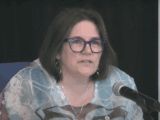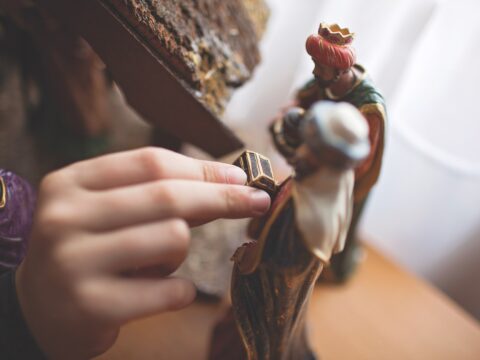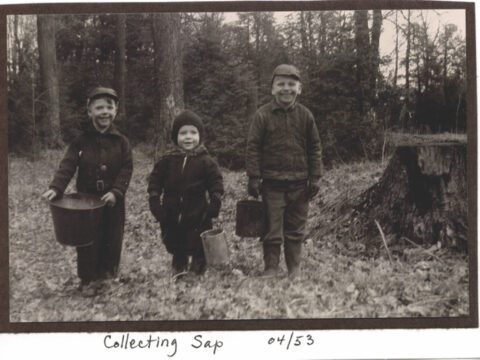When Rev. David Mundy’s parents divorced 40 years ago, his father, a United Church minister, stayed in his home congregation while his mother searched for a new church. “She ended up feeling like she was persona non grata,” says Mundy, lead minister at Bridge Street United in Belleville, Ont. “Back then, there was really nothing to support people in the church who got divorced.”
Contrast this with the experience of Janice Meighan, a “rituals specialist” who performed a divorce ceremony five years ago for a Toronto couple in their 30s. “They wanted it to be meaningful and didn’t want their friends and family to feel they had to take sides,” recalls Meighan, a member of West Hill United in Toronto. Her business, Rituals Without Borders, offers ceremonies commemorating everything from marriage to menopause.
The divorcing couple invited 50 people to the ceremony, which was followed by a wine and cheese reception. They spoke about the hopes they had when they first married and how they still cared for and respected each other. Then they burned a copy of their marriage certificate in a glass bowl using the candle they had lit at their wedding. Guests were invited to contribute a flower to a special “bouquet of love and affection.” At the end of the 45-minute service, the parting couple gave their weddings rings back to each other. There wasn’t a dry eye in the house.
If the idea of spouses dissolving their marriage in such a loving way sounds radically enlightened, well, even Meighan admits to a twinge of divorce-ceremony envy. When she split from her first husband more than 20 years ago, “there was too much pain” to formally mark their parting, she says. “But when I did that ceremony, I saw what a powerful healing process it could be.”
Forty percent of Canadian marriages end in divorce. Those who go through it commonly describe the experience as one of the most painful of their lives. Yet there are few established rituals that offer the emotional and spiritual closure couples often need. Some argue that marriages start with ceremony and should end the same way — that marking this significant life event can help prevent adversarial and costly court proceedings, reduce the emotional impact on children and allow the couple to move on. Separation rites can also help church communities when they find themselves caught in the middle of a marriage falling apart.
Some faith groups are helping people leave marriage thankful for the good times and supported by the ties of family and community. Since the 1960s, Unitarian Universalists have offered divorcing couples a “Ceremony of Hope.” In the United States, the United Church of Christ — currently negotiating formal ties with The United Church of Canada — introduced a divorce service some 30 years ago. The United Methodist Church has a long prayer for divorcing couples; pastors can conduct divorce ceremonies if they choose to. Reform Judaism has a “Ritual of Release” for divorcing couples, while Conservative and Orthodox Judaism have the traditional “get” — a bill of divorce initiated by the husband.
Resources currently offered by the United Church’s liturgical resource, Celebrate God’s Presence, are limited to two prayers that might apply to separating couples: one for when a partner leaves and another for a couple in distress. “Celebrate God’s Presence has rituals and liturgies for everything from blessing a fleet to prayers for a pet’s death. So why can’t we develop more resources for divorce?” asks Mundy. He adds that “there was absolutely nothing in seminary” to prepare him for aiding parishioners through a breakup.
Rev. Rob Dalgleish, executive director of the United Church’s EDGE Network for Ministry Development, helps create United Church liturgy. He admits that the prayer for separating people “was a toe in the water” toward helping divorcing couples, and agrees more could be offered. “We’ve stigmatized and privatized” the grief around divorce, he says, noting that the creation of additional resources, whether prayers, congregational blessing, rituals or an actual ceremony, would be an opportunity to “bring grace and healing — our spiritual tradition has a lot to offer in this area.”
Eyes rolled last year when actor Gwyneth Paltrow and musician Chris Martin released a statement on Paltrow’s website describing the end of their 10-year marriage as a “conscious uncoupling” — a process originated by Los Angeles-based therapist Katherine Woodward Thomas, where couples mark the end of a marriage with intention and meaning, not rancour.
Honouring the end of a marriage is just too weird and unconventional for some people. The Guardian’s Anne Perkins called the accompanying essay on Paltrow’s website possibly “the most deluded 2,000 words of tosh ever to be associated with sentient adults.” Other critics argue that conscious uncoupling sugarcoats the fact that divorce hurts, and that one party often ends up hurting more than the other.
And divorce still carries the stain of failure, even if a couple enjoyed many good years together and produced much-loved children. Prominent New York therapist Lauren Howard claims ceremonial uncoupling makes everyone uncomfortable — “except for the un-couple who bask in their ‘superior’ amiability.” She argues in the Huffington Post, “There is a big difference between handling disagreement maturely and pretending there is no disagreement. Divorce does not have to be about hate, but it cannot be about love.”
Still, couldn’t trying to salvage a little love and care at the end of a floundering marriage lessen the massive fall-out from divorce — the estrangement, wounded children, decimated finances, and in-laws and friends who feel compelled to take sides?
Janet Webber of Halifax is one of only two Canadian coaches certified in the conscious uncoupling process. She works with clients to help them “focus on the love they shared rather than the mistakes that occurred” — to accept shared responsibility for the breakup, avoid blame and shield children and themselves from toxic feelings and actions. The process also includes creating a customized healing ritual to allow them to move forward.
The five-week program costs about $500 for weekly one-on-one counselling ($300 for the digital version) — a lot cheaper than divorce court, notes Webber. “Many people going through a divorce behave uncharacteristically badly — it brings out the worst in people.” After working out their issues in her program, she says couples often feel “transformed” and are able to minimize the rancour and even appreciate each other.
Divorce rituals don’t have to be elaborate affairs, nor do both parties have to be involved. A partner may choose, for example, to bury a wedding ring with just a few close friends present. Webber says many of her clients do the conscious uncoupling program on their own. “One person alone has the power to change the dynamic in a relationship,” she says.
In their book, A Healing Divorce: Transforming the End of Your Relationship with Ritual and Ceremony, Phil and Barbara Penningroth argue that ritual is one of the most creative ways to transition from being married to being single: “The more conscious you can make your parting, the more life-affirming the end of your relationship will be for you and your family.”
The duo wrote the book after creating their own divorce ceremony when their 25-year marriage ended. It was held at a southern California retreat surrounded by citrus groves and featured a video of their years together against a soundtrack of their wedding song, Jesu, Joy of Man’s Desiring.
Vancouver divorce coach Marilyn Beloff tailors end-of-marriage ceremonies to a couple’s religious beliefs or their ethnic, cultural and family traditions — candles for Catholics or drumming for Aboriginal people, for example. Ritualized endings “release you to love someone else, and when you do them in front of witnesses, there is something very spiritual and visceral that happens,” she says.
Publicly marking the end of a marriage can not only benefit the parting couple; if they belong to a faith community, it can also be helpful to their fellow parishioners. David Mundy recalls “one terrible year” in a parish when there were seven breakups in the congregation — including two choir members who left their spouses for each other. “Not only was it difficult for the individuals involved, but it was hard on the congregation as well,” he says.
Divorce ceremonies might have lessened the awkwardness and acrimony for everyone. And they might make it easier for both sides in a breakup to remain part of the congregation — often one or the other falls by the wayside.
Should churches consider taking a page from the conscious uncoupling workbook to help those going through the agony of dismantling their marriage? Janet Webber thinks so. “Divorce is often described as a ‘living death’ — a time when people are feeling an extreme amount of grief. Often they don’t get support from the one place where they should — the church. “Faith groups,” notes Beloff, “already have the infrastructure and the understanding of the importance of ritual in sacred space and community — it’s the perfect place to do this, and yet they are falling short.”
David Mundy agrees: “One of the things we in the United Church are earnest about is not stigmatizing people who have gone through divorce. We have been accepting about this much longer than other churches. But we’ve never really said . . . what are we doing on a practical level to help people?” The lack of leadership isn’t “a matter of judgment or indifference — it’s just general confusion about what to do.” Maybe the time is right to turn good intentions to action.
***
This story first appeared in The United Church Observer’s February 2015 issue with the title “With this ring I thee divorce.”














